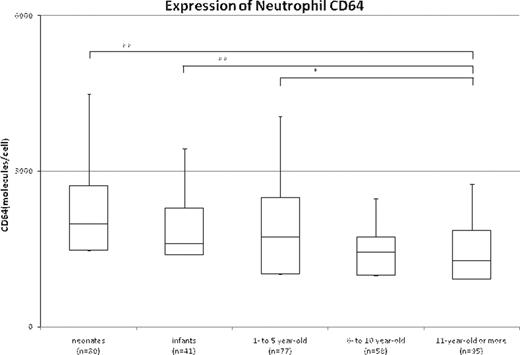Abstract
Abstract 4930
To develop the use of CD64 expression as an early diagnostic of adult collagen disease, we elucidated normal levels in neonates, infants and children.
Blood samples were collected from a total of 62 symptom- and infection-free subjects recruited at our outpatient department: neonates (n=80), infants (n=41), 1- to 5-year-old children (n=77), 6- to 10-year-old children (n=58), children 11 years old or older and adults (n=95). CD64 expression per neutrophil was quantitatively determined by flow cytometry using a BD FACS Calibur HG flow cytometer (Becton Dicknson, BD) and BD CellQuest Pro analysis software (BD). Fluorescence was measured and converted to number of CD64 molecules per cell using a phycoerythrin (PE) fluorescence kit (Quantibrite PE; BD Biosciences) according to the manufacturer's instructions. This study was approved by the ethics committee of Iwate Medical University.
CD64 expression level in neonates (median, 1981 molecules per neutrophil; range, 908–9844), infants (1666.5, 572–12941), and 1- to 5-year-old children (1778, 545–11283) was significantly higher than that in children 11 years old or older and adults (1280, 533–11205) (p<0.01 or <0.05). There were no differences in expression between 6- and 10-year-old children (1529, 439–9214) and children 11 years old or older and adults.
Our results suggest that the normal value for adults can not be applied for neonates, infants, and 1- to 5-year-old children. To use CD64 expression level on neutrophils as an infection marker in neonates, infants and 1- to 5-year-old children cut-off values higher than that in adults must be established.
No relevant conflicts of interest to declare.
Author notes
Asterisk with author names denotes non-ASH members.


This feature is available to Subscribers Only
Sign In or Create an Account Close Modal